A few years ago, I undertook the effort of writing a 12-part series on Old School Magic. In the first article, I took pains to define Old School as a set or range of formats, rather than a particular format, like 93/94. While readers might be most familiar with 93/94, I offered a number of other examples, including 1995 Type II or non-historical formats, such as Commander formats that permit sets through Alliances. The keystone of ‘Old School’ is a set of Magic formats that exclude the most recent sets – an anti-Standard paradigm.
Despite the enormous range of possibilities, most players seem content enjoying the 93/94 experience over and over again. In my view, that’s like going to a sushi bar and only trying the tuna rolls. There is so much more on the menu!
As much as I accept the mantle of “Old School Player,” I self-identify much more as Type I player. Although I played and enjoyed constructed Magic prior to the creation of the Type I format at the beginning of 1995, it was under the auspices of Type I where I found my home, and my passion as a Magic player. Type I defined and distilled the elements I enjoyed most in Magic, and the schism of constructed Magic in to Type I and Type II allowed for greater differentiation of Magic community subgroups to emerge.
This delineation occurred on several axes. On one dimension, it allowed players to segregate among new and old, among “Mr. Suitcase” and budget players, and so on. Although I was barely a teenager, I was an older Magic player by the time Type I was created. On another dimension, Type I was regarded as a home for more broken and unfair cards, and therefore filtered out more casual play in the early years. Large group games and kitchen table magic may have loosely followed Type I construction rules, but were rarely regarded as “Type I play.”
Unfortunately, 93/94 can hardly capture the full range of experiences enjoyed by a Type I player in the mid-1990s. Ice Age in particular was a major turning point, and a dramatic metagame correction against The Deck, with Jester’s Cap and Necropotence. 1995 Old School is such a rich experience that I organized a tournament in Berkeley in late 2016 that extended traditional American Old School Magic 6 months forward, by allowing Ice Age. Ice Age opens up many new strategies, but the one that I enjoyed playing in our local event, and winning the tournament with, was Reanimator, which is boosted enormously with Dance of the Dead and other tactics.
1996 Old School
Part of the fun of Old School is employing hard-won insights from 25 years of Magic, peering backwards into older formats. Although I enjoyed 1995 Old School a great deal, I thought it would be an exciting exercise to continue to try introducing novel Old School environments to our community. So, a few months ago, I announced to our Bay Area Old School group my plans to organize a 1996 Old School event for the evening of March 8 at a local gamer-friendly pub.
I decided to give away a pair of Golgothian Sylex to the first and second place finishers.
There are only two sets from 1996, Alliances and Mirage. So I had to decide whether to include just Alliances or both. Alliances is a major departure from previous formats, in that Force of Will is permitted, and a number of other cards such as Gorilla Shaman are also introduced. Eternal Central’s recommended Old School 96 rules permits Mirage as well. After reviewing the sets, I determined that Mirage introduces intriguing deck building components without being overpowered on its own, and therefore serves the goal of offering up interesting deck options. It is the Mirage expansion set, Visions, that more fundamentally changes game play, with the introduction of Prosperity and Vampiric Tutor in 1997.
Drawing a line between Mirage and Visions maximizes deck building options without overly bending them in one direction or another. I felt that this was a rich and rewarding environment to explore. The next question, however, was what to change or modify in the Banned and Restricted List.
Having tested and experienced 1995 Old School, I knew that I would want Necropotence restricted, contrary to the recommendations of the Eternal Central for ’95 Old School. My issue with Necropotence is not that it can’t be beaten or is overpowered, but that it polarizes the format between Necro decks, anti-Necro decks, and other decks. It inhibits and contracts deck building options. That logic extends into the 1996 Old School format.
Superficially, the scariest card in Mirage may be Flash, but, upon closer inspection, there appeared to be nothing to use it with, as cards like Academy Rector or even Great Whale come to print later. In advance of the event, I invited players to identify potentially broken combos with Flash that might warrant its restriction. None were found.
Both Mystical Tutor and Enlightened Tutor arrive in Mirage. Neither is necessarily broken, but Mystical Tutor easily goes into control decks to find cards like Balance. It might not need to be restricted from a pure competition perspective, but restricting it keeps deck building options more expansive.
Mana Crypt, Mana Vault, and Lion’s Eye Diamond all exist in the 1996 format, but they were collectively first broken with the arrival of Visions. It remained an open – and tantalizing question – as to whether they could be broken without Prosperity. The Recursion deck with Forgotten Lore I discussed in my 12-part series would seem eminently viable, but could be kept in check by both Tormod’s Crypt and Force of Will. I was willing to allow that, as I felt anyone enterprising and daring enough to work on that deserved to be able to play it.
Given that Forgotten Lore exists, I also see no reason to restrict Recall, so I unrestricted that as well. I departed from the Eternal Central-suggested list in a few other respects as well. With Strip Mine unrestricted, I see no reason whatsoever to restrict Maze of Ith.
Although I strongly disagree with unrestricting Strip Mine in many Old School environments, as it tends to make Tempo and Aggro decks dominate to an unreasonable degree, sets such as Ice Age and Alliances introduce a number of specialized lands such as Kjeldoran Outpost and Glacial Chasm that deserve to have a more reliable answer. Also, with such fast acceleration available for combo decks and more counter-tactics and ways to protect your lands, I feel that Strip Mine is less oppressive in 1996 Old School. Therefore, Strip Mine and Maze of Ith would be unrestricted.
In reviewing my History of Vintage chapters in this period and at the history of Banned and Restricted List policy, it is notable that Storm Cauldron and Fastbond create a very powerful mana engine that functions like Channel, and even better when paired with Glacial Chasm. At 6 mana however, I felt that it was worth permitting. So that was a conspicuous exemption, also an invitation to courageous deck builders.
There was but one issue left to resolve: Demonic Consultation. In 1995 Magic, Demonic Consultation proved vital to both the Reanimator and Power Artifact combo decks, which both did very well. I was concerned that with Force of Will, the Power Artifact combo deck would be even more powerful. Therefore, I had to decide whether to restrict Consultation to help keep it in check. I felt that Consultation opened up more deck options than simply restricting Power Artifact, so I restricted Power Artifact instead. Demonic Consultation can’t be used by Restricted List-heavy decks like the Recursion deck or The Deck, so it is not available to every strategy for abuse.
Therefore, here is the Restricted List I settled on for this event, and would recommend again for Old School ’96:
Restricted List:
Ancestral Recall
Balance
Black Lotus
Braingeyser
Channel
Chaos Orb
Demonic Tutor
Library of Alexandria
Mana Drain
Mind Twist
Mox Emerald
Mox Jet
Mox Pearl
Mox Ruby
Mox Sapphire
Mystical Tutor
Necropotence
Power Artifact
Regrowth
Sol Ring
Time Vault
Time Walk
Timetwister
Wheel of Fortune
Because we would only have time for 3-4 rounds (I announced 3 rounds of Swiss plus one more playoff round to determine final standings, if necessary), I simply banned Shahrazad to prevent anyone from using it to waste time.
With these rules in place, I began to explore possible deck options. The Recursion deck was very attractive to me, but having played Reanimator before, I was wary of having to contend with multiple rounds of Tormod’s Crypts. Therefore, I ruled this out.
In talking with my friend Paul Mastriano, he made a very compelling case for using the Browse + Soldevi Digger combo, which he used to win an Old School tournament in Pittsburgh back in 2010, one of the first ever held in the States. As he explained it, the combo quickly filters through your deck until you set up a boundless Time Walk loop much like Time Vault and Voltaic Key in contemporary Vintage. That strategy seemed very powerful to me.
But there was one other combo that I felt would be more fun, if not as effective: Illusionary Mask and Phyrexian Dreadnaught.
MaskNaught
A weird errata in the winter of 2001 fundamentally changed longstanding rulings on how Illusionary Mask could be used, and now allowing Mask to preclude creatures “Comes into play” abilities, most usefully those with drawbacks, such as Phyrexian Dreadnaught or Lord of Tresserhorn. This errata opened the door to a new Type I strategy in 2002, which was subject of the first strategy article I ever wrote on Magic. Since that time, however, further errata has modified the functionality of Illusionary Mask in a number of respects, but nonetheless retained this valuable interaction. I resolved to focus my efforts on building the best 1996 MaskNaught deck I could.
Based upon my previous work on the archetype, I had a strong sense of what I was looking for. Cramming everything I wanted into a 60 card deck was a difficult task, as was trying to find room for 4 Force of Wills and enough blue cards to support them. Here is what I ended up playing:
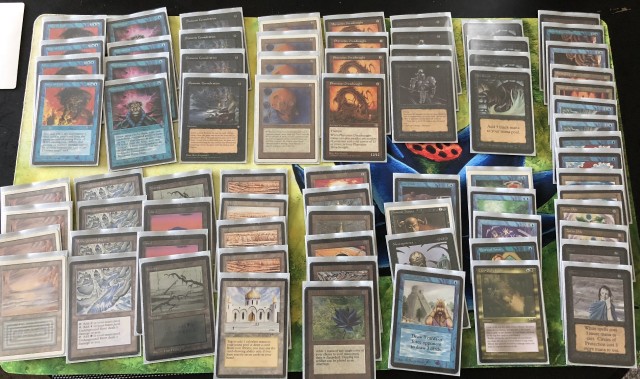
MaskNaught 1996, by Stephen Menendian
| Business (33) 4 Force of Will 1 Mana Drain 4 Brainstorm 1 Ancestral Recall 1 Time Walk 1 Timetwister 1 Necropotence 4 Demonic Consultation 1 Mystical Tutor 1 Demonic Tutor 1 Lim-Dul's Vault 1 Recall 4 Illusionary Mask 4 Phyrexian Dreadnought 4 Hypnotic Specter Mana Sources (27) 4 Dark Ritual 1 Black Lotus 1 Mox Jet 1 Mox Pearl 1 Mox Ruby 1 Mox Sapphire 1 Sol Ring 1 Library of Alexandria 4 Strip Mine 4 Underground Sea 4 Underground River 2 Swamp 2 Island | Sideboard (15) 1 Island 2 Hurkyl's Recall 2 Tormod's Crypt 2 Flash Counter 2 Blue Elemental Blast 2 City in a Bottle 2 Zuran Orb 2 Gloom |
Brainstorm and Demonic Consultation have a powerful synergy, so I decided to run both in maximal quantities. The MaskNaught combo itself consumes 8 slots. Dark Ritual is a natural inclusion, and easily supports Hypnotic Specter as a backup and complementary plan. I wanted to run a few Lord of Tresserhorn, but it tested slowly in goldfishing, and, what’s worse, could not be played, even under Mask, without red mana. So I picked up a few at my local shop, but quickly cut them not long in the development process.
Lim-Dul’s Vault tested very well in goldfishing, so I included one, as well as a number of other restricted blue cards. 4 Strip Mine would be auto-included to combat Glacial Chasm, Maze of Ith, and other tactics, as well as for disruptive effect. Underground River was a necessary card for black and blue color consistency, but I also wanted enough basics as a hedge against Blood Moon. I cannot explain the absence of Chaos Orb except to say that I simply forgot it. I shaved the off-color Mox Emerald to make room for the Lim-Dul’s Vault.
As for the sideboard, I already mentioned how important Tormod’s Crypt would be in this environment, and planned to have at least a couple in my sideboard. Gloom is one of the best cards against both White Weenie decks, but also quite good at decks with Swords to Plowshares and Disenchant, which are a nuisance for me. Zuran Orb is a nice tactic against burn decks and a way to keep Necropotence going. Flash Counter would come in against control decks, and Blue Elemental Blast against Gorilla Shaman and Atog decks. Hurkyl’s Recall was there for the mirror and Workshop decks.
Game Day
On the evening of March 8, seven players and a few spectators showed up to play some Old School Magic at the Albatross Pub in Berkeley (California, USA). This meant that we would be able to play 3 rounds with a player getting the bye (with the worst record) each round.
Round 1 vs. John Delustro (Zoo)
I played Jon way back in one of our very first Bay Area Old School events, and he was playing the same deck again: Zoo. This time, with Gorilla Shaman in tow.
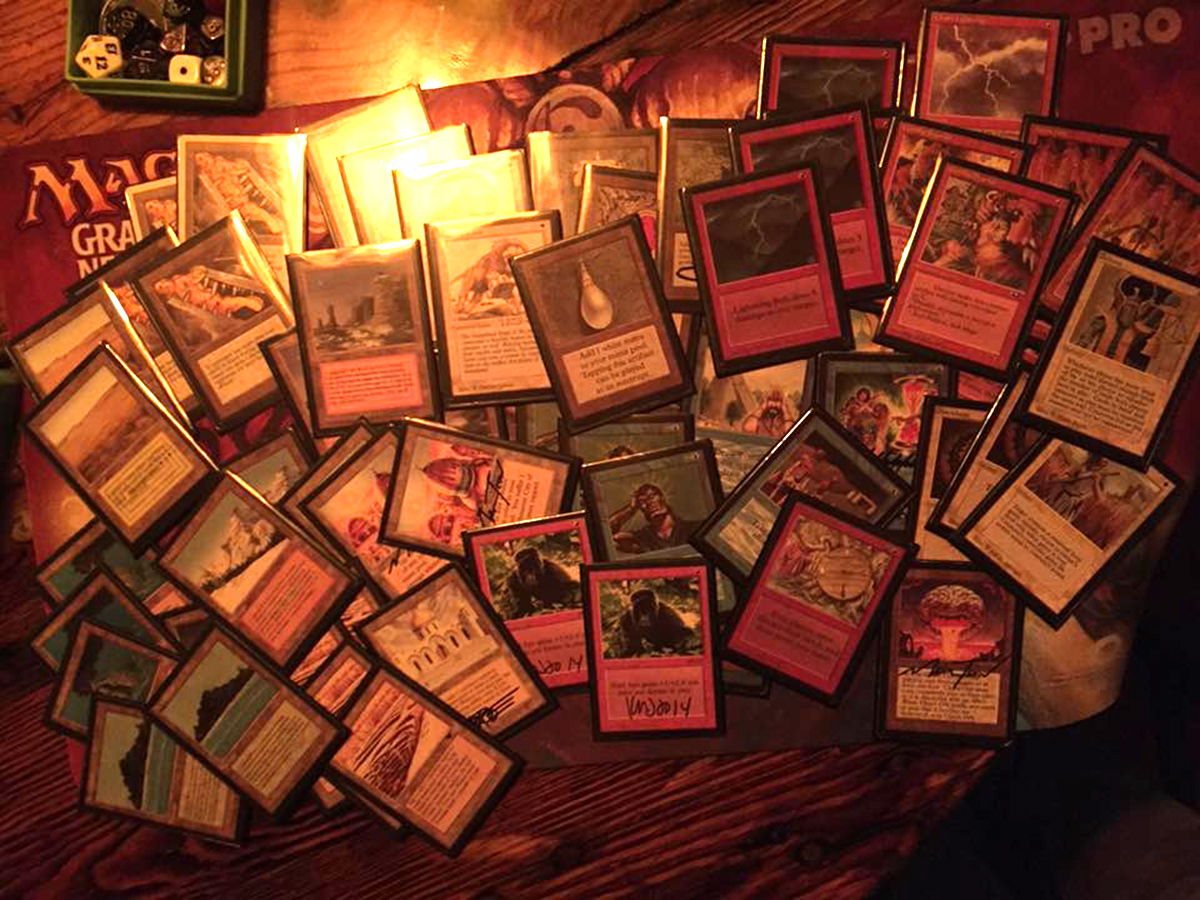
Although Jon won the die roll, in the first game, I nearly unloaded my entire hand. He led with a Savannah Lions, but I played a Mox Sapphire, and cast Brainstorm. I played Underground Sea, Mox Pearl and Sol Ring, and used the Sol Ring to play Illusionary Mask, and cast Phyrexian Dreadnought face down. He played a Strip Mine, and oddly passed the turn. It soon became clear why. I went to attack him, and he cast Disenchant after I flipped over the Dreadnaught. I cast Mana Drain on it, and struck him for 12. I greedily Consulted for another Dreadnought and played it. He drew his card for the turn, and then scooped.
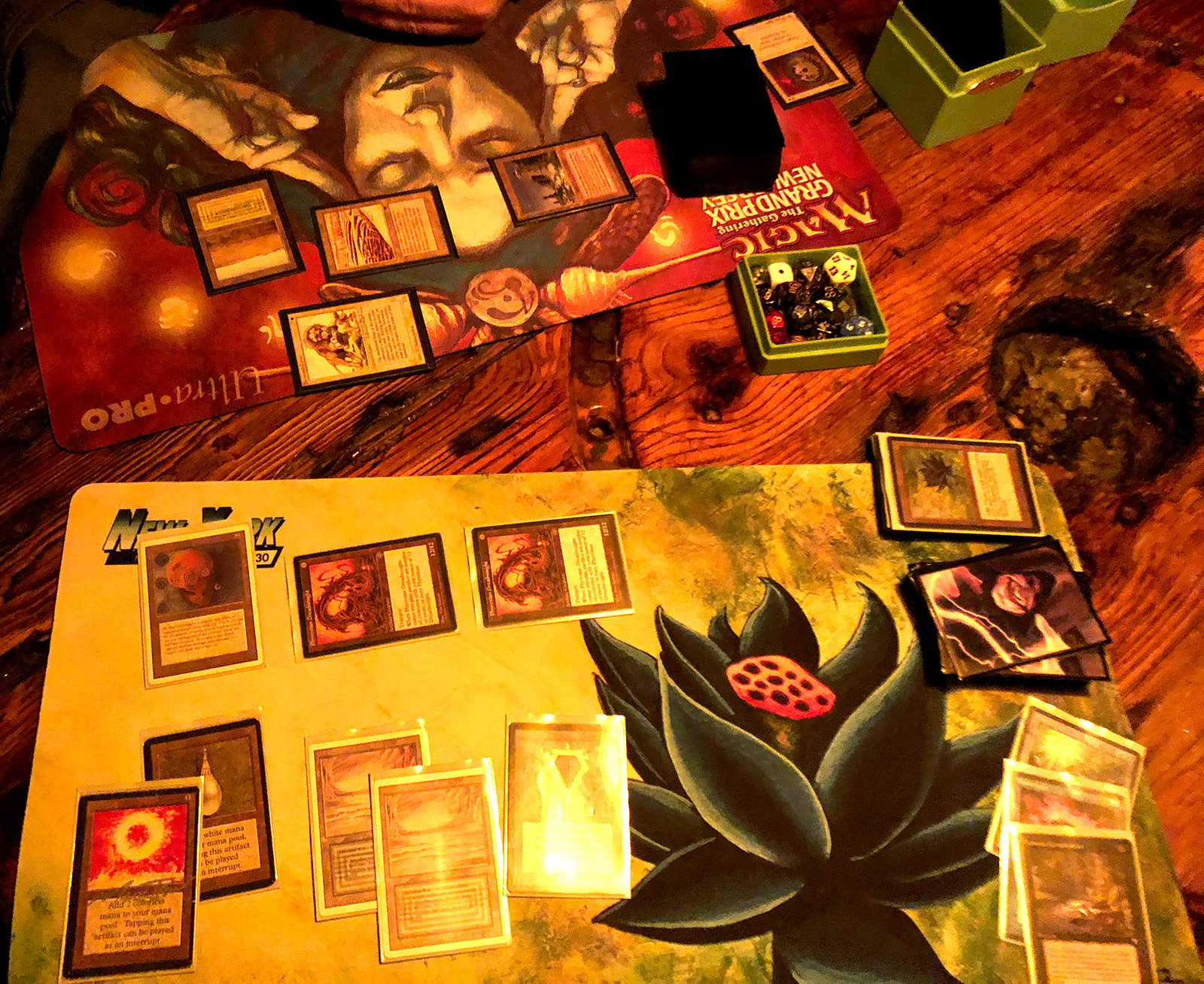
In the second game, I greedily fed off of Necropotence and a supplementary Library of Alexandria, but then Demonic Tutored for something unimportant instead of a Zuran Orb, and found myself quickly at his mercy with a cluster of Bolts which I couldn’t counter.
In the third game, my hand was questionable: Mox Jet, Strip Mine, Illusionary Mask, Demonic Consultation, Force of Will, Brainstorm, and Mana Drain.
I played a first turn Mask, and passed back. He played Mox, land, and cast Merchant Scroll for Ancestral Recall. I drew Lim-Dul’s Vault, and cast Demonic Consultation for Phyrexian Dreadnaught, and then played it. He cast Ancestral, and I decided to let it resolve, simply because I just had to stop removal, if he had any. He played a Maze of Ith, but I Stripped that, and attacked him. He Regrowthed Ancestral, and this one I countered with Force. He drew a blank for the turn, and I killed him with Dreadnought.
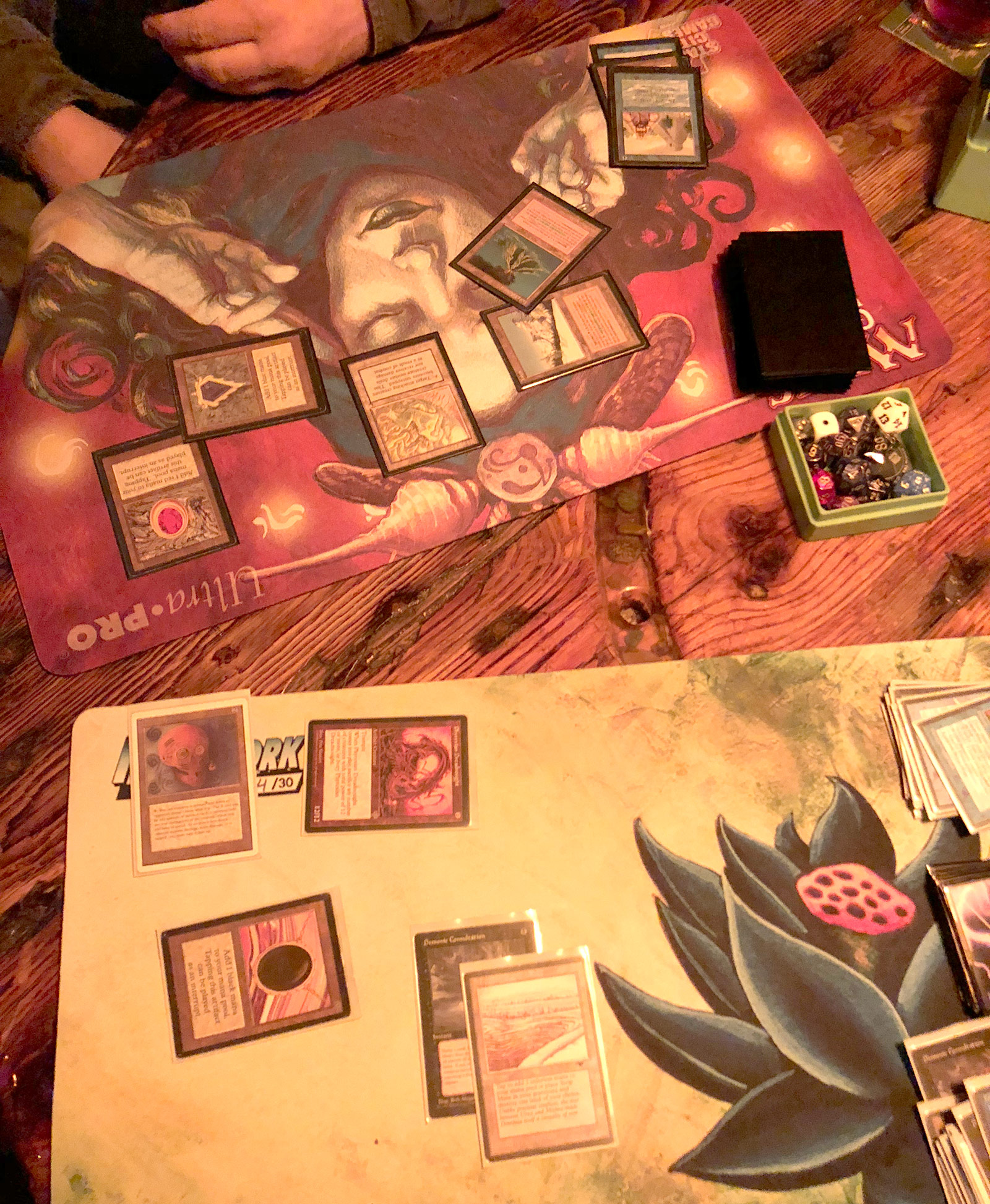
Record: 1-0, 2-1
Round 2 vs. Brian Hanlon (Blue Skies)
Brian is a good friend, and a great guy who made the trip from Sacramento to play some Old School. He was playing a Flying Man/Serendib deck, and didn’t know what I was playing.
Here was my opening hand in our first game:

He led with Island, Flying Men. My opening hand introduced several lines of play, but I felt the most powerful would be to simply play Illusionary Mask and then pass, giving me Time Walk as an additional attack step. He played a Factory on his second turn, and cast Time Walk, and then attacked with Factory and Flying Men again, bringing me to 16.
On my second turn, I drew Strip Mine, and played it. I then cast Dreadnaught, and then Time Walk. On my Time Walk turn, I Stripped his Island. He drew a card, and then scooped.
I sideboarded in a pair of City in a Bottles and both Flash Counters.
In our second game, I led with Dark Ritual into Hypnotic Specter, but he had a second turn Serendib Efreet that I couldn’t answer. I drew Force of Will the next turn. He played Tolaria and cast Serendib Djinn, which I considered letting resolve, but decided against. He attacked me, and I attacked him back, stripping Counterspell and Mana Drain over consecutive turns. Unfortunately, I couldn’t assemble the combo, and died not long after he played Unstable Mutation on the Efreet.
The third game was much more to my liking. Here was my opening hand:
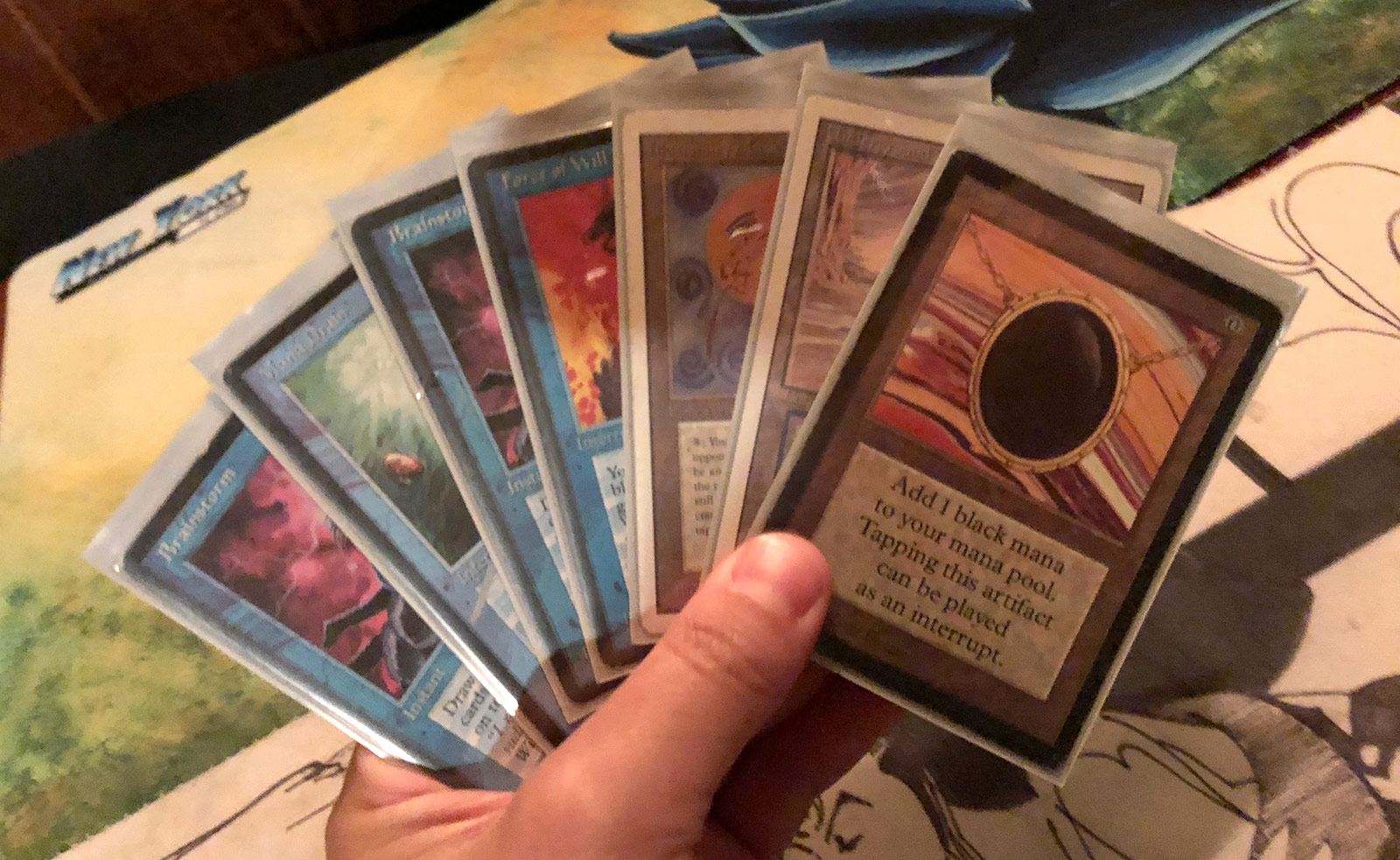
I resolved a first turn Mask, and my turn 2 Brainstorm revealed a Dreadnaught and a Mystical Tutor. I played an Island and held up Drain and Force so that I could Mystical for Time Walk on his end step to end the game. That’s exactly what happened. He played Ancestral and a Flying Men with Unstable Mutation, but I smashed him to death with a 12/12 Dreadnought.
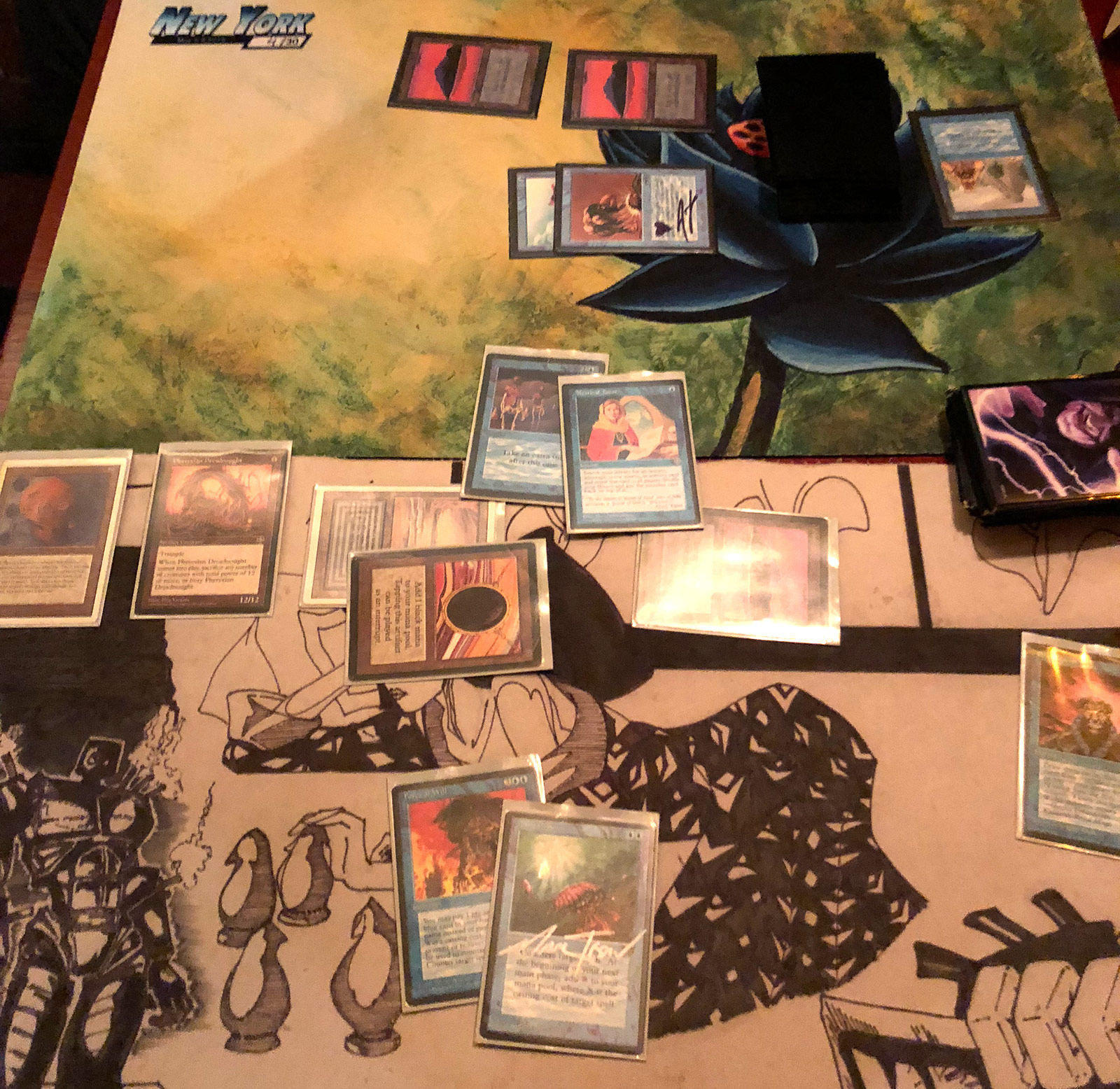
Record: 2-0, 4-2
Round 3 vs. Hampton Maxwell (Atog Burn)
Hampton is one of the more crotchety players in our community, but a strong competitor. I was not surprised that he was the only other 2-0 player in the field. His deck presented some challenges, with Gorilla Shamans and speed. I am a little hazy on the particulars, but here is a rough sketch of what occurred. In the first game, he emptied his hand, but his Wheel of Fortune ran in to my Force of Will. I believe I then played Demonic Tutor for Necropotence, and used Necro to take over the game.
In the second game, I recall playing a Hypnotic Specter, and then used it to empty his hand of Pyroblast and other disruption, and Strip Mined his only blue mana source. Eventually, I assembled the MaskNaught combo and killed him in the first attack with Dreadnaught.

Record: 3-0, 6-2
I was the only undefeated player, and had the best overall record. However, there was a three way tie in both matches and games for 2nd place. The winner of that match, Eliot, wanted to play me, so I offered to play him for fun. We played two quick games. In the first game, I played this sequence of cards on the first turn:
Black Lotus, Brainstorm, Underground River, Dark Ritual, Demonic Tutor, Illusionary Mask, Phyrexian Dreadnought with Force of Will protection. I drew Swamp on my second turn of the game. Here was my hand, board and graveyard:

In our second game, I Consulted for a Dark Ritual, but removed 3 Masks in the process. I used the Ritual, however, to cast Necropotence. The Necro found me Demonic Tutor, which found the last Mask, and I deployed two Dreadnoughts with multiple counterspells protecting them.
Final Record: 4-0, 8-2
I expected MaskNaught to be good, but I didn’t quite expect to be quite this consistent. Almost every design choice I made proved better than expected. The Hypnotic Specters held their own. Lim-Dul’s Vault was very good. Brainstorm supplemented by Demonic Consultation meant that I was never concerned about Brainstorm locking myself. Even if Demonic Consultation were restricted, I would probably play the same deck. In fact, that would make it easy for me to find space for the accidentally-omitted Chaos Orb. From there, I could see adding a second Lim-Dul’s Vault, a Merchant Scroll, or even another Recall. Two of those cards provided post-Brainstorm shuffles.
1996 Old School is great fun. The period from late 1996 until roughly 2000 is a Dark Age for Type I play, as there were very few recorded tournament results. Given discoveries and deck building advances since, and odd errata, there is much space for innovation and refinement. It is a ripe area of exploration for intrepid Old School players.
My fellow competitors shared my enthusiasm for the format, although many were just happy to be playing Old School. In an informal poll afterward about what we should try next, whether we should rewind to Ice Age or earlier, try this same format again, or move forward in time, the consensus was to expand to try Visions next.
That’s now may plan. Because Visions introduces Prosperity, we will probably need to restrict Prosperity and Vampiric Tutor, and possibly Demonic Consultation as well. I’ll be sure to share how it goes!
Until next time,
Stephen Menendian

